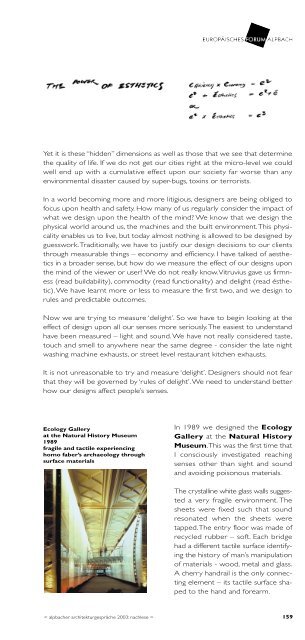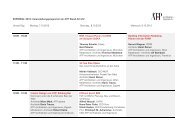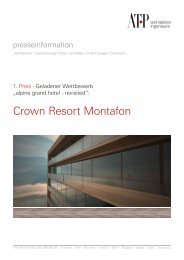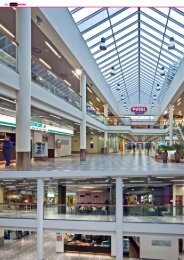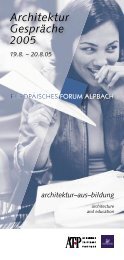alpbacher architekturgespräche 2003 - ATP
alpbacher architekturgespräche 2003 - ATP
alpbacher architekturgespräche 2003 - ATP
Erfolgreiche ePaper selbst erstellen
Machen Sie aus Ihren PDF Publikationen ein blätterbares Flipbook mit unserer einzigartigen Google optimierten e-Paper Software.
Yet it is these “hidden” dimensions as well as those that we see that determine<br />
the quality of life. If we do not get our cities right at the micro-level we could<br />
well end up with a cumulative effect upon our society far worse than any<br />
environmental disaster caused by super-bugs, toxins or terrorists.<br />
In a world becoming more and more litigious, designers are being obliged to<br />
focus upon health and safety. How many of us regularly consider the impact of<br />
what we design upon the health of the mind? We know that we design the<br />
physical world around us, the machines and the built environment.This physicality<br />
enables us to live, but today almost nothing is allowed to be designed by<br />
guesswork.Traditionally, we have to justify our design decisions to our clients<br />
through measurable things – economy and efficiency. I have talked of aesthetics<br />
in a broader sense, but how do we measure the effect of our designs upon<br />
the mind of the viewer or user? We do not really know.Vitruvius gave us firmness<br />
(read buildability), commodity (read functionality) and delight (read ésthetic).We<br />
have learnt more or less to measure the first two, and we design to<br />
rules and predictable outcomes.<br />
Now we are trying to measure ‘delight’. So we have to begin looking at the<br />
effect of design upon all our senses more seriously.The easiest to understand<br />
have been measured – light and sound.We have not really considered taste,<br />
touch and smell to anywhere near the same degree - consider the late night<br />
washing machine exhausts, or street level restaurant kitchen exhausts.<br />
It is not unreasonable to try and measure ‘delight’. Designers should not fear<br />
that they will be governed by ‘rules of delight’.We need to understand better<br />
how our designs affect people’s senses.<br />
Ecology Gallery<br />
at the Natural History Museum<br />
1989<br />
fragile and tactile experiencing<br />
homo faber’s archaeology through<br />
surface materials<br />
In 1989 we designed the Ecology<br />
Gallery at the Natural History<br />
Museum.This was the first time that<br />
I consciously investigated reaching<br />
senses other than sight and sound<br />
and avoiding poisonous materials.<br />
The crystalline white glass walls suggested<br />
a very fragile environment. The<br />
sheets were fixed such that sound<br />
resonated when the sheets were<br />
tapped.The entry floor was made of<br />
recycled rubber – soft. Each bridge<br />
had a different tactile surface identifying<br />
the history of man’s manipulation<br />
of materials - wood, metal and glass.<br />
A cherry handrail is the only connecting<br />
element – its tactile surface shaped<br />
to the hand and forearm.<br />
< <strong>alpbacher</strong> <strong>architekturgespräche</strong> <strong>2003</strong>: nachlese > 159


